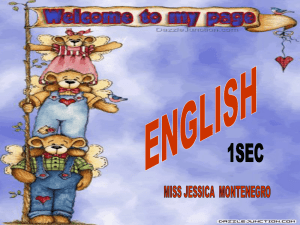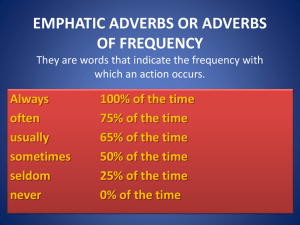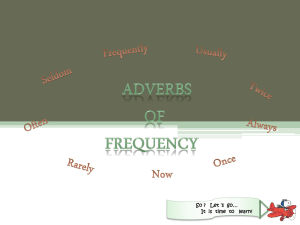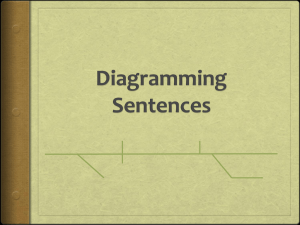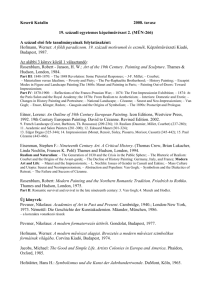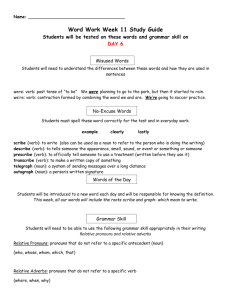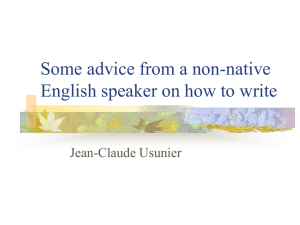Angol_9-12
advertisement
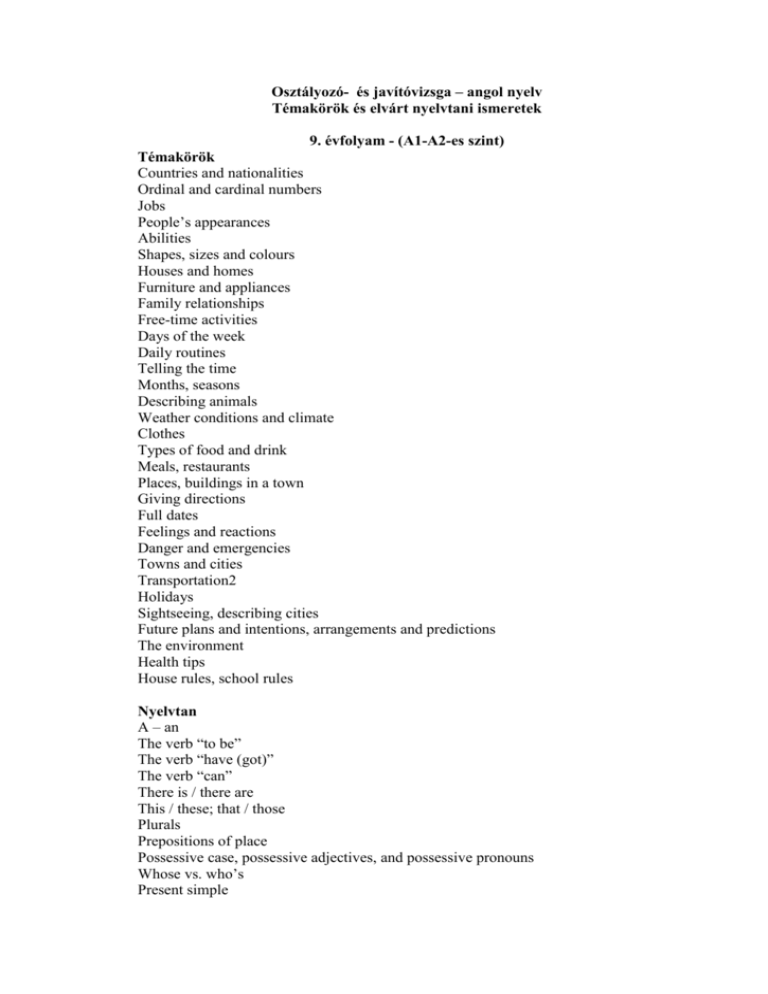
Osztályozó- és javítóvizsga – angol nyelv Témakörök és elvárt nyelvtani ismeretek 9. évfolyam - (A1-A2-es szint) Témakörök Countries and nationalities Ordinal and cardinal numbers Jobs People’s appearances Abilities Shapes, sizes and colours Houses and homes Furniture and appliances Family relationships Free-time activities Days of the week Daily routines Telling the time Months, seasons Describing animals Weather conditions and climate Clothes Types of food and drink Meals, restaurants Places, buildings in a town Giving directions Full dates Feelings and reactions Danger and emergencies Towns and cities Transportation2 Holidays Sightseeing, describing cities Future plans and intentions, arrangements and predictions The environment Health tips House rules, school rules Nyelvtan A – an The verb “to be” The verb “have (got)” The verb “can” There is / there are This / these; that / those Plurals Prepositions of place Possessive case, possessive adjectives, and possessive pronouns Whose vs. who’s Present simple Adverbs of frequency Prepositions of time Question words (Wh-questions and Yes/No questions) Present continuous Present continuous vs. Present simple Countable / uncountable nouns Some / any; how much / how many; (a) few / (a) little The past forms of the verb “to be”: was / were The past form of the verb “have”: had The past form of the verb “can”: could Past simple Prepositions of movement Adjectives and adverbs Comparisons “be going to” and Future simple Present continuous (future meaning) Modals: should, shouldn’t, must, mustn’t, can, can’t Present perfect simple 10. évfolyam - (A2-es szint) Témakörök People’s physical appearance and character Jobs and job qualities Everyday activities Describing places Daily routines Telling the time School subjects Shops and shopping Feelings and reactions Plans3 Food and drink Service at restaurants Health and illnesses Accidents Changes Landmarks (museums, inventors, etc.) Giving instructions Warnings and signs Rules The environment Air pollution Rainforests and endangered species Animals and pets Holiday resorts Weather Festivals, national holidays Clothes Technology (computers and the Internet) Nyelvtan Present simple vs. Present continuous Adverbs of frequency Past simple ”used to” Order of adjectives Making comparisons Past simple vs. Past continuous Adjectives and adverbs Joining sentences Future simple ”be going to” Present continuous (future meaning) Conditionals (Types 1, 2) Time clauses (when, before, after, etc.) A / an / some / any; much / many; (a) few / (a) little Giving advice (should) Present perfect simple Present perfect continuous Past perfect simple Past perfect continuous Past perfect vs. Past continuous The passive voice The imperative; exclamations, instructions Question tags Modals: might, could, have to / had to, mustn’t, can, be allowed to Relative clauses Infinitive vs. –ing form Say vs. tell Reported speech (statements and questions) 11. évfolyam (B1-es szint) Témakörök Sports (extreme sports) Travel and leisure Jobs (CVs, motivation letters) Giving opinions about books and films Transportation, problems about public transport Means of transport The media: magazines, TV, newspapers, the Internet Radio and TV programmes Advertising Talking about learning Personality and career Food Famous places Describing lifestyles Civilization Talking about historical events (dates and periods of history, etc.) Nyelvtan Present simple, Present continuous, Present perfect State and activity verbs Past perfect Present perfect simple and continuous “used to” vs. “would” The passive voice The causatives: “to have sth done” Expressing the future: Future simple, “be going to”, may / might, Present simple, Present continuous Infinitives and –ing forms Modals for speculating: must, might, can’t Conditionals (Types 0, 1, 2, 3) I wish / If only Relative Clauses Reported speech (statements and questions) Past modals 12. és 13. évfolyam (B1-B2-es szint; készülés az érettségi vizsgára) Témakörök (megegyeznek a középszintű érettségi vizsga szóbeli részének témaköreivel) 1. Family and friends. Social life 2. Education, learning languages. Life-long learning. 3. Jobs. Earning a living. 4. Holidays and celebration. Superstitions 5. Fashion and clothes 6. Daily routine. Habits 7. Health and illness 8. Home. Housing and flats 9. Meals and eating out 10. Shopping and Services. Advertising 11. Communication 12. Computer and the Information technology 13. Entertainment and media 14. Hobbies 15 Sports and games 16. Travelling, tourism, sightseeing 17. Traffic 18. Environment 19. Weather and climate Beszédszándékok útbaigazítás egyetértés és ellenvélemény meglepetés és sajnálkozás kifejezése érzelmek árnyalt kifejezése tárgyak, személyek leírása, jellemzése Fogalomkörök, nyelvtan a korábbi tanévek nyelvtani anyagának kibővítése, pontosítása időbeli viszonyok – függő beszéd, igeidők egyeztetése gerund és infinitive használata és szerepe a mondatszerkesztésben szóképzés – a leggyakoribb elő- és utóképzők a feltételesség és a vágy/óhaj kifejezése would rather, it’s time, had better használata hasonlítás; melléknevek és összehasonlító mondatok alárendelt mondatok a leggyakoribb vonzatos igék (phrasal verbs) A dölt betűs részek a 13. évfolyamra vonatkoznak. Mivel az idegen nyelvek esetében minden tanév anyaga a korábbi tanévek anyagára épül, az osztályozó vizsgán alapkövetelmény az előző tanévek anyagának az ismerete. Ajánlott tankönyvek: 9. évfolyam: Real Life Elementary, Longman Pearson Kiadó. New English File Elementary, Oxford Kiadó 10. évfolyam: Real Life Elementary/Pre-Intermediate New English File Pre-Intermediate. 11. évfolyam: Real Life Intermediate, Longman Pearson Kiadó. New English File Intermediate, Oxford Kiadó 12. évfolyam: Érettségi Aktivátor, Longman Pearson Kiadó. Oxford Exam Excellence, Oxford Kiadó. Színes érettségi feladatsorok, Maxim Kiadó. 13. évfolyam: Exam Accelerator, Longman Pearson Kiadó. Nyelvi szintek a Közös Európei Referenciakeretben:
